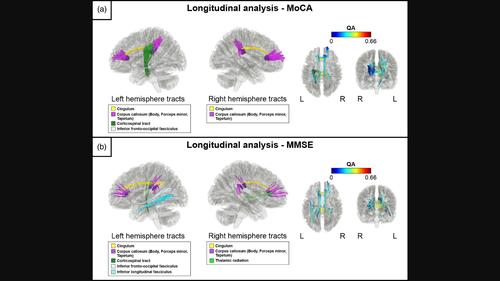当前位置:
X-MOL 学术
›
Hum. Brain Mapp.
›
论文详情
Our official English website, www.x-mol.net, welcomes your feedback! (Note: you will need to create a separate account there.)
Structural brain networks correlating with poststroke cognition
Human Brain Mapping ( IF 4.8 ) Pub Date : 2024-03-23 , DOI: 10.1002/hbm.26665 Sonia L. E. Brownsett 1, 2, 3 , Leeanne M. Carey 4, 5 , David Copland 1, 2, 3 , Alistair Walsh 4, 5 , Aleksi J. Sihvonen 1, 2, 3, 6
Human Brain Mapping ( IF 4.8 ) Pub Date : 2024-03-23 , DOI: 10.1002/hbm.26665 Sonia L. E. Brownsett 1, 2, 3 , Leeanne M. Carey 4, 5 , David Copland 1, 2, 3 , Alistair Walsh 4, 5 , Aleksi J. Sihvonen 1, 2, 3, 6
Affiliation

|
Cognitive deficits are a common and debilitating consequence of stroke, yet our understanding of the structural neurobiological biomarkers predicting recovery of cognition after stroke remains limited. In this longitudinal observational study, we set out to investigate the effect of both focal lesions and structural connectivity on poststroke cognition. Sixty‐two patients with stroke underwent advanced brain imaging and cognitive assessment, utilizing the Montreal Cognitive Assessment (MoCA) and the Mini‐Mental State Examination (MMSE), at 3‐month and 12‐month poststroke. We first evaluated the relationship between lesions and cognition at 3 months using voxel‐based lesion‐symptom mapping. Next, a novel correlational tractography approach, using multi‐shell diffusion‐weighted magnetic resonance imaging (MRI) data collected at both time points, was used to evaluate the relationship between the white matter connectome and cognition cross‐sectionally at 3 months, and longitudinally (12 minus 3 months). Lesion‐symptom mapping did not yield significant findings. In turn, correlational tractography analyses revealed positive associations between both MoCA and MMSE scores and bilateral cingulum and the corpus callosum, both cross‐sectionally at the 3‐month stage, and longitudinally. These results demonstrate that rather than focal neural structures, a consistent structural connectome underpins the performance of two frequently used cognitive screening tools, the MoCA and the MMSE, in people after stroke. This finding should encourage clinicians and researchers to not only suspect cognitive decline when lesions affect these tracts, but also to refine their investigation of novel approaches to differentially diagnosing pathology associated with cognitive decline, regardless of the aetiology.
中文翻译:

与中风后认知相关的结构性大脑网络
认知缺陷是中风的常见且令人衰弱的后果,但我们对预测中风后认知恢复的结构神经生物学生物标志物的理解仍然有限。在这项纵向观察研究中,我们着手研究局灶性病变和结构连接对中风后认知的影响。 62 名中风患者在中风后 3 个月和 12 个月接受了先进的脑成像和认知评估,利用蒙特利尔认知评估 (MoCA) 和简易精神状态检查 (MMSE)。我们首先使用基于体素的病变症状映射评估了 3 个月时病变与认知之间的关系。接下来,一种新颖的相关纤维束成像方法,使用在两个时间点收集的多壳扩散加权磁共振成像 (MRI) 数据,用于评估 3 个月时的横断面和纵向白质连接组与认知之间的关系(12 减 3 个月)。病变-症状图谱没有产生显着的发现。反过来,相关纤维束成像分析揭示了 MoCA 和 MMSE 评分与双侧扣带回和胼胝体之间的正相关性,无论是在 3 个月阶段的横断面还是纵向上。这些结果表明,一致的结构连接组而不是局灶性神经结构,支撑着两种常用认知筛查工具 MoCA 和 MMSE 在中风后患者中的表现。这一发现应该鼓励临床医生和研究人员不仅在病变影响这些束时怀疑认知能力下降,而且要完善他们对新方法的研究,以区分诊断与认知能力下降相关的病理学,无论病因如何。
更新日期:2024-03-23
中文翻译:

与中风后认知相关的结构性大脑网络
认知缺陷是中风的常见且令人衰弱的后果,但我们对预测中风后认知恢复的结构神经生物学生物标志物的理解仍然有限。在这项纵向观察研究中,我们着手研究局灶性病变和结构连接对中风后认知的影响。 62 名中风患者在中风后 3 个月和 12 个月接受了先进的脑成像和认知评估,利用蒙特利尔认知评估 (MoCA) 和简易精神状态检查 (MMSE)。我们首先使用基于体素的病变症状映射评估了 3 个月时病变与认知之间的关系。接下来,一种新颖的相关纤维束成像方法,使用在两个时间点收集的多壳扩散加权磁共振成像 (MRI) 数据,用于评估 3 个月时的横断面和纵向白质连接组与认知之间的关系(12 减 3 个月)。病变-症状图谱没有产生显着的发现。反过来,相关纤维束成像分析揭示了 MoCA 和 MMSE 评分与双侧扣带回和胼胝体之间的正相关性,无论是在 3 个月阶段的横断面还是纵向上。这些结果表明,一致的结构连接组而不是局灶性神经结构,支撑着两种常用认知筛查工具 MoCA 和 MMSE 在中风后患者中的表现。这一发现应该鼓励临床医生和研究人员不仅在病变影响这些束时怀疑认知能力下降,而且要完善他们对新方法的研究,以区分诊断与认知能力下降相关的病理学,无论病因如何。



























 京公网安备 11010802027423号
京公网安备 11010802027423号